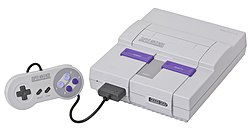- PC Engine CoreGrafx II with Super CD-ROM2
| |
| Part of a series on the |
| History of video games |
|---|
In the history of video games, the fourth generation of video game consoles, more commonly referred to as the 16-bit era, began on October 30, 1987, with the Japanese release of NEC Home Electronics' PC Engine (known as the TurboGrafx-16 in North America). Though NEC released the first console of this era, sales were mostly dominated by the rivalry between Sega and Nintendo across most markets: the Mega Drive (known as the Genesis in North America) and the Super Nintendo Entertainment System (known as the Super Famicom in Japan). Cartridge-based handheld game consoles became prominent during this time, such as the Game Boy, Lynx, Game Gear, and TurboExpress.
Contents
- Differences from third generation consoles
- Home systems
- TurboGrafx-16
- Mega Drive/Genesis
- Super NES
- Compact Disc Interactive (CD-i)
- Neo Geo
- Add-ons
- European importing
- Comparison
- Other consoles
- Worldwide sales standings
- Handheld systems
- List of handheld consoles
- Other handheld game consoles
- Milestone titles
- See also
- Notes
- References
Nintendo was able to capitalize on its success in the third generation, and managed to win the largest worldwide market share in the fourth generation as well. However, particularly in the lucrative North American market, there was a fierce console war in the early 1990s, which eventually saw Sega taking a market share lead over Nintendo in North America by 1993. Sega's success in this era stemmed largely from its launch of its popular Sonic the Hedgehog franchise to compete with Nintendo's Super Mario series, as well as a very stylized marketing campaign aimed at American teenagers. Several other companies released consoles in this generation, but none of them were widely successful. Nevertheless, there were other companies that started to take notice of the maturing video game industry and begin making plans to release consoles of their own in the future. As with prior generations, game media still continued to be distributed primarily on ROM cartridges, though the first optical disc systems, such as the Philips CD-i, were released to limited success. There was additionally competition with games on home computers such as the Amiga, Atari ST, Apple IIGS, and IBM PC compatibles, especially in markets like Europe. As games became more complex, concerns over violence in games like Mortal Kombat and Night Trap led to the creation of the Entertainment Software Rating Board.
The emergence of fifth generation video game consoles, beginning around 1994, did not initially significantly diminish the popularity of fourth generation consoles. In 1996, however, there was a major drop in sales of hardware from this generation and a dwindling number of software publishers supporting its systems, [1] which together led to a drop in software sales in subsequent years.





































